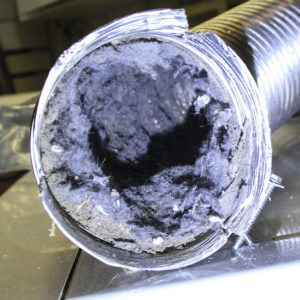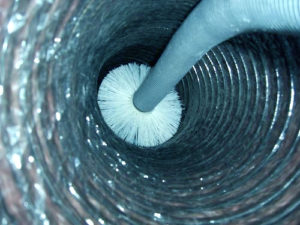Dryer Vent Cleaning
What you can expect during a dryer vent cleaning?
Your appliance(s) may be moved to allow access during our dryer vent cleaning job. The vent will be inspected with a small but powerful camera prior to any work being done and again after cleaning has been completed.
 Once the vent system has been inspected the cleaning process will take approximately 45-60 minutes. Professional grade brush and flex rods are used to complete the job along with a strong vacuum to catch the lint during cleaning.
Once the vent system has been inspected the cleaning process will take approximately 45-60 minutes. Professional grade brush and flex rods are used to complete the job along with a strong vacuum to catch the lint during cleaning.
When the job is completed time is spent with the homeowner to review the cleaning process, share inspection results and view the inside of the now clean dryer vent using the inspection camera.
Dryer Fires and How to Prevent Them?
What causes fires?
One of the most common causes of dryer fires is lack of maintenance. When lint traps aren’t cleaned as often as they should be, the resulting build-up in the screen or other areas can cause the dryer to perform poorly, operate at elevated temperatures and possibly overheat – with dangerous consequences. Vent systems must also be checked and cleaned to maintain proper air flow for the same reasons.
Problems may also occur if consumers place improper items in their dryers, such as foam backed rugs or athletic shoes, or vent their appliances with plastic or vinyl exhaust materials. Make sure that whatever you put in your dryer is approved and safe to place in a dryer. When in doubt, check the washing instructions on the tag of the clothing or consult the manufacturers website for more information.
What can you do ?
An important safeguard your family can take is to ensure that your dryer has rigid or flexible metal venting and ducting materials to help sustain airflow. This will also reduce operating costs and extend the life of the dryer and clothing due to lower drying temperatures.
Additionally dryer vent cleaning tips:
- Clean the lint trap before and after drying each load of clothes.
- Don’t forget to clean the back of the dryer where lint can be trapped.
- The interior of the dryer and venting system should be cleaned periodically by qualified service personnel. If you notice the drying time is longer, clean the vent system thoroughly to ensure proper airflow.
- Replace plastic or vinyl exhaust hoses with rigid or flexible metal venting.
- Do not dry clothing/fabric on which there is anything flammable (alcohol, cooking oils, gasoline, spot removers, dry-cleaning solvents, etc.). Flammable substances give off vapors that could ignite or explode.
- Don’t forget to read manufacturers’ warnings in use and care manuals that accompany new dryers. Also, warning markings can usually be found on the inside of the dryer’s lid and take only minutes to read.
Dryer Vent Cleaning Indicators:
- Damp clothes now takes longer to dry
- You’ve noticed your cloths are hotter than usual at the end of the drying cycle
- The top of your dryer is hotter to the touch than normal or the exterior vent flap does not open freely when the dryer is operating.
All of these are indicators and consistent with reduced air flow exhausting through the dryer vent system due to possible lint build-up or blockage which could contribute to a vent fire.
[vc_icon color=”text” size=”sm” link=”” external=”0″ icon_fontawesome=”fa fa-bell”] Did you know that?
- Clothes dryers can be found in 80 percent, or 81.5 million homes throughout the United States.
- A full load of wet clothes placed in a dryer contains about one half gallon of water. As water is removed, lint is created from the clothes.
- Clothes dryers are one of the most expensive appliances in your home to operate. The longer it runs, the more money it costs you.
- The U.S. Consumer Product Safety Commission (CPSC) estimates that 15,500 fires associated with clothes dryers occur annually. These fires account for an average of 10 deaths and 310 injuries and more than $84.4 million in property damage annually.
- On a positive note, the number of clothes dryer fires has dropped by 35 percent from the 24,000 fires that occurred annually, on average, in the late 1970s.
Call Us Today
Still have questions give us a call, we look forward to hearing from you.
or click here to contact us.